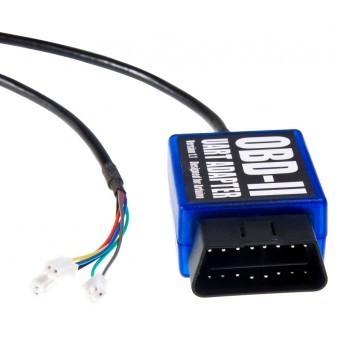The OBD-II UART Adapter for Arduino serves as a crucial bridge, seamlessly connecting your vehicle’s On-Board Diagnostics II (OBD-II) port to the serial UART interface of your Arduino microcontroller. This innovative tool empowers you to effortlessly extract a wealth of real-time data from your car’s Engine Control Unit (ECU) computer, including vital parameters like speed, engine RPM, and much more. Coupled with a dedicated Arduino library, accessing and interpreting this data becomes remarkably straightforward, opening up a world of possibilities for automotive enthusiasts and DIY makers.
Beyond basic OBD-II data retrieval, this adapter integrates a sophisticated MPU-6050 sensor module. This embedded module houses an accelerometer, gyroscope, and temperature sensor, all communicating via the I2C interface. The accelerometer allows for precise measurement of your vehicle’s acceleration and steering G-force, valuable for performance analysis or advanced driver assistance systems. Simultaneously, the gyroscope provides accurate readings of your car’s orientation, offering an alternative to GPS-based solutions for navigation and motion tracking applications.
 Arduino OBD2 UART Adapter showcasing its OBD-II connector and breakout cable with power, data (Rx/Tx), and I2C sensor connectors, simplifying vehicle data access.
Arduino OBD2 UART Adapter showcasing its OBD-II connector and breakout cable with power, data (Rx/Tx), and I2C sensor connectors, simplifying vehicle data access.
Furthermore, the adapter intelligently manages power delivery. It taps into the 12V DC power supply from the OBD-II port, efficiently converting and regulating it to a stable 5V DC output. This regulated power is then readily available to power your Arduino and any additional devices connected to it, streamlining your project’s power management.
The adapter itself features a standard OBD-II connector, designed for secure and reliable plug-and-play connectivity into your vehicle’s OBD-II port, typically located beneath the dashboard. Extending from the adapter is a cable that neatly terminates in three distinct connectors: a power connector (VCC/GND), an OBD-II data connector (Rx/Tx) for UART communication, and an I2C sensor connector (SDA/SCL). These connectors are designed for easy interfacing with Arduino boards, whether using standard breakout pins or a breakout shield. This design ensures a clean and organized setup within your car, minimizing cable clutter and simplifying integration.
Frequently Asked Questions about the OBD2 UART Adapter
Q: How does the Arduino Obd2 Uart Adapter receive its power?
A: The adapter is powered directly from your car’s OBD-II port, which provides a 12V DC power source. It efficiently draws power from this port to operate.
Q: Will I need an external power source for my Arduino when using this adapter?
A: No, you will not. The adapter is designed to simplify your setup by providing a regulated 5V DC power output. This output is specifically intended to power your Arduino board. By connecting the adapter’s power connector (VCC/GND) to your Arduino’s 5V and GND pins, you eliminate the need for any separate power supply for the Arduino.
Q: Is a CAN bus shield required to utilize this adapter?
A: Absolutely not. One of the key advantages of this adapter is that it handles the complexities of the CAN bus interface for you. It internally retrieves data from the CAN bus network, similar to how a CAN bus shield operates. However, instead of presenting the more complex CAN bus interface, it converts the data into a simple serial UART interface. This UART interface is easily accessible and compatible with Arduino and a wide range of embedded systems. The adapter’s data connector (Rx and Tx) provides this simplified data stream.
Q: What is the procedure for connecting the adapter to my Arduino?
A: Connecting the OBD2 UART Adapter to your Arduino is designed to be user-friendly and compatible with all Arduino models. Utilizing the dedicated Arduino library provided for the adapter, the connection process is straightforward. You simply need to connect the adapter’s Tx pin to the Arduino’s Rx pin (typically digital pin D0) and the adapter’s Rx pin to the Arduino’s Tx pin (typically digital pin D1). For users who anticipate frequent connection and disconnection, employing a common I/O breakout shield or an Arduino board equipped with breakout pins for Rx/Tx/VCC/GND is highly recommended. This approach streamlines the connection process and enhances the ease of use.
Q: Is the power supply from the adapter consistently available, even when the car is off?
A: The availability of power from the OBD-II port after the car’s ignition is turned off is vehicle-dependent. In the majority of modern vehicles, the OBD-II port remains powered even after the ignition is off. However, it is advisable to consult your vehicle’s manual or conduct a test to confirm the power behavior of your specific car’s OBD-II port in different ignition states.